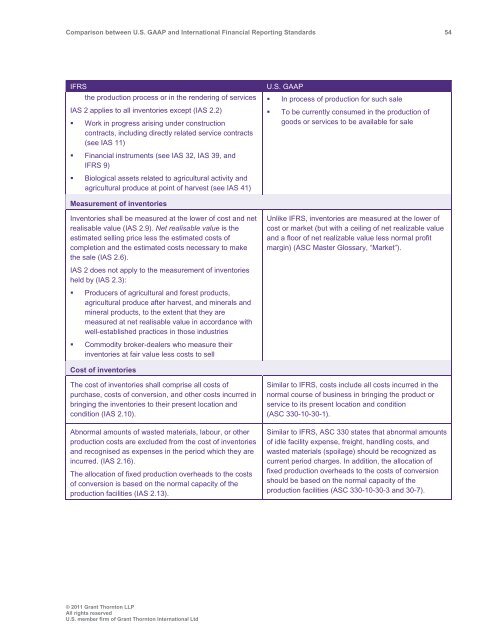Comparison between U.S. GAAP and International ... - Grant Thornton
Comparison between U.S. GAAP and International ... - Grant Thornton
Comparison between U.S. GAAP and International ... - Grant Thornton
Create successful ePaper yourself
Turn your PDF publications into a flip-book with our unique Google optimized e-Paper software.
<strong>Comparison</strong> <strong>between</strong> U.S. <strong>GAAP</strong> <strong>and</strong> <strong>International</strong> Financial Reporting St<strong>and</strong>ards 54<br />
IFRS<br />
the production process or in the rendering of services<br />
IAS 2 applies to all inventories except (IAS 2.2)<br />
• Work in progress arising under construction<br />
contracts, including directly related service contracts<br />
(see IAS 11)<br />
• Financial instruments (see IAS 32, IAS 39, <strong>and</strong><br />
IFRS 9)<br />
• Biological assets related to agricultural activity <strong>and</strong><br />
agricultural produce at point of harvest (see IAS 41)<br />
U.S. <strong>GAAP</strong><br />
• In process of production for such sale<br />
• To be currently consumed in the production of<br />
goods or services to be available for sale<br />
Measurement of inventories<br />
Inventories shall be measured at the lower of cost <strong>and</strong> net<br />
realisable value (IAS 2.9). Net realisable value is the<br />
estimated selling price less the estimated costs of<br />
completion <strong>and</strong> the estimated costs necessary to make<br />
the sale (IAS 2.6).<br />
Unlike IFRS, inventories are measured at the lower of<br />
cost or market (but with a ceiling of net realizable value<br />
<strong>and</strong> a floor of net realizable value less normal profit<br />
margin) (ASC Master Glossary, “Market”).<br />
IAS 2 does not apply to the measurement of inventories<br />
held by (IAS 2.3):<br />
• Producers of agricultural <strong>and</strong> forest products,<br />
agricultural produce after harvest, <strong>and</strong> minerals <strong>and</strong><br />
mineral products, to the extent that they are<br />
measured at net realisable value in accordance with<br />
well-established practices in those industries<br />
• Commodity broker-dealers who measure their<br />
inventories at fair value less costs to sell<br />
Cost of inventories<br />
The cost of inventories shall comprise all costs of<br />
purchase, costs of conversion, <strong>and</strong> other costs incurred in<br />
bringing the inventories to their present location <strong>and</strong><br />
condition (IAS 2.10).<br />
Abnormal amounts of wasted materials, labour, or other<br />
production costs are excluded from the cost of inventories<br />
<strong>and</strong> recognised as expenses in the period which they are<br />
incurred. (IAS 2.16).<br />
The allocation of fixed production overheads to the costs<br />
of conversion is based on the normal capacity of the<br />
production facilities (IAS 2.13).<br />
Similar to IFRS, costs include all costs incurred in the<br />
normal course of business in bringing the product or<br />
service to its present location <strong>and</strong> condition<br />
(ASC 330-10-30-1).<br />
Similar to IFRS, ASC 330 states that abnormal amounts<br />
of idle facility expense, freight, h<strong>and</strong>ling costs, <strong>and</strong><br />
wasted materials (spoilage) should be recognized as<br />
current period charges. In addition, the allocation of<br />
fixed production overheads to the costs of conversion<br />
should be based on the normal capacity of the<br />
production facilities (ASC 330-10-30-3 <strong>and</strong> 30-7).<br />
© 2011 <strong>Grant</strong> <strong>Thornton</strong> LLP<br />
All rights reserved<br />
U.S. member firm of <strong>Grant</strong> <strong>Thornton</strong> <strong>International</strong> Ltd
















